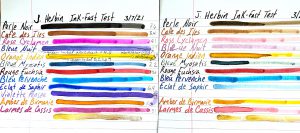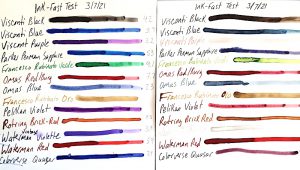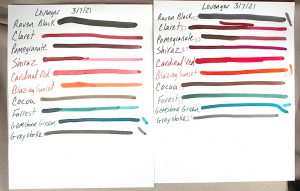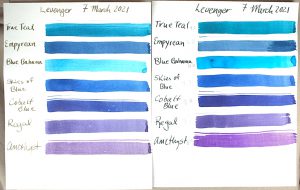French inks haven’t previously undergone our rigorous testing, and we were excited to give them a UV light-fast test and pH test. We purchased a small collection of a dozen different colors of J. Herbin.
We started this test on March 7, 2021, by placing a sample of 13 inks in our sunniest window.

We test these J. Herbin inks to see how well they can withstand UV light and to see where they rank on the ol’ pH meter.
Believe it or not, this was our first time writing with J. Herbin ink. What really struck us was the vibrancy of the dry ink on the page. Of the colors I liked best, Rose Cyclamen really pops with a purple-pink splendor. Dawn’s favorite color is the electric turquoise blue of Bleu Pervenche. Eclat de Saphir is a solid daily blue. And my new permanent addition to my daily writing is the Amber de Birmanie. It is an incredible orangy brown.
Unfortunately, 3 months of direct sunlight does not treat these inks well. All of the colors except the gold metallic ink bleach substantially in UV light. You can see the damage in the photo. Some of the really drastic changes include Rose Cyclamen turning bright, light bubble-gum pink; the blue-black Bleu Nuit turns a pale, faded purple and Violette Pensee disappears almost completely! Larmes de Cassis turns from purple to pink.
The following show the pH results for each ink. We actually had three different bottles of the Bleue Nuit, Orange Indien and Bleu Pervenche. The labels on the outside of the bottle were different, so we list these two inks by their label results, too. As a quick refresher in chemistry, a pH number of 0 is as acidic as a chemical can be. 7 is neutral, like pure water. And 14 is the maximum extreme of alkali/base.
Perle Noir 7.6
Cafe des Iles 3.4
Rose Cyclamen 4.1
Bleue Nuit 4.0 (Green Label)
Bleue Nuit 6.9 (White & Blue Label)
Orange Indien 4.9 (Green Label)
Orange Indien 6.9 (White & Blue Label)
Bleue Myosotis 2.2
Rouge Fuchsia 4.6
Bleu Pervenche 7.0 (White & Blue Label)
Bleu Pervenche 6.2 (Green Label)
Eclat de Saphir 6.4
Violette Pensee 4.4
Amber de Birmanie 5.8
Larmes de Cassis 7.1


 Shopping Cart
Shopping Cart







